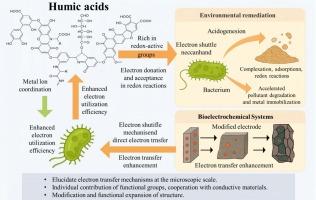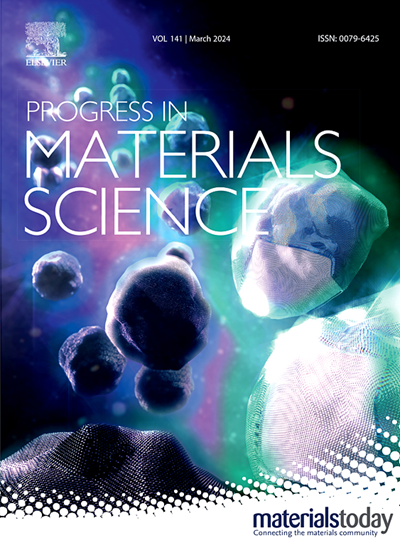A comprehensive review on nature-inspired redox systems based on humic acids: Bridging microbial electron transfer and high-performance supercapacitors
IF 40
1区 材料科学
Q1 MATERIALS SCIENCE, MULTIDISCIPLINARY
引用次数: 0
Abstract
Humic acids (HAs) have attracted increasing attentions owing to their vibrant bioelectrochemical activities. Although recent research on HAs demonstrated their ability to promote electron transfer via quinone and phenolic moieties, which allow them to perform various functions in metal immobilization, microbial energy metabolism, and pollutant degradation. The underlying redox mechanisms are still unclear and occasionally reported as contradictory. According to this study, electron shuttling and metal ion-mediated internal electron “bridges” are probably essential to the functional roles of HAs in microbial systems. As natural redox mediators and electron conductors, HAs facilitate microbial metabolism and enhance redox efficiency through direct and indirect pathways. Furthermore, in bioelectrochemical systems, HAs serve as effective electrode modifiers or electron transfer enhancers, improving charge storage and transport efficiency. However, numerous unresolved queries remain regarding their structure–function interactions, synergies with conductive materials, and microscale electron transport behavior. Existing research often overlooks the structural and performance instability of HAs under different environmental conditions, leading to reduced predictability of its application effectiveness. Future research should explore the mechanisms underlying HAs’ role in microbial community succession and the dynamic changes in electron transfer pathways to provide innovative strategies for sustainable development.

基于腐植酸的自然激发氧化还原系统综述:桥接微生物电子转移和高性能超级电容器
腐植酸(HAs)由于其活跃的生物电化学活性而受到越来越多的关注。尽管最近对HAs的研究表明它们能够通过醌和酚基团促进电子转移,这使得它们在金属固定,微生物能量代谢和污染物降解中发挥各种功能。潜在的氧化还原机制尚不清楚,有时报道相互矛盾。根据本研究,电子穿梭和金属离子介导的内部电子“桥”可能是HAs在微生物系统中发挥功能作用的必要条件。HAs作为天然的氧化还原介质和电子导体,通过直接和间接途径促进微生物代谢,提高氧化还原效率。此外,在生物电化学系统中,HAs作为有效的电极修饰剂或电子转移增强剂,提高电荷存储和传输效率。然而,关于它们的结构-功能相互作用、与导电材料的协同作用和微尺度电子传递行为,仍有许多未解决的问题。现有的研究往往忽略了HAs在不同环境条件下的结构和性能的不稳定性,导致其应用效果的可预测性降低。未来的研究应探索HAs在微生物群落演替中的作用机制和电子传递途径的动态变化,为可持续发展提供创新策略。
本文章由计算机程序翻译,如有差异,请以英文原文为准。
求助全文
约1分钟内获得全文
求助全文
来源期刊

Progress in Materials Science
工程技术-材料科学:综合
CiteScore
59.60
自引率
0.80%
发文量
101
审稿时长
11.4 months
期刊介绍:
Progress in Materials Science is a journal that publishes authoritative and critical reviews of recent advances in the science of materials. The focus of the journal is on the fundamental aspects of materials science, particularly those concerning microstructure and nanostructure and their relationship to properties. Emphasis is also placed on the thermodynamics, kinetics, mechanisms, and modeling of processes within materials, as well as the understanding of material properties in engineering and other applications.
The journal welcomes reviews from authors who are active leaders in the field of materials science and have a strong scientific track record. Materials of interest include metallic, ceramic, polymeric, biological, medical, and composite materials in all forms.
Manuscripts submitted to Progress in Materials Science are generally longer than those found in other research journals. While the focus is on invited reviews, interested authors may submit a proposal for consideration. Non-invited manuscripts are required to be preceded by the submission of a proposal. Authors publishing in Progress in Materials Science have the option to publish their research via subscription or open access. Open access publication requires the author or research funder to meet a publication fee (APC).
Abstracting and indexing services for Progress in Materials Science include Current Contents, Science Citation Index Expanded, Materials Science Citation Index, Chemical Abstracts, Engineering Index, INSPEC, and Scopus.
 求助内容:
求助内容: 应助结果提醒方式:
应助结果提醒方式:


